宏观经济学-第二版-课后习题答案
- 格式:docx
- 大小:1.09 MB
- 文档页数:59
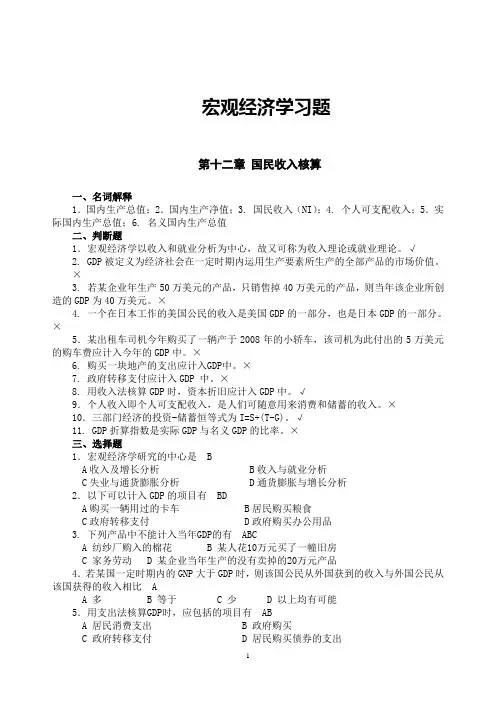
宏观经济学习题第十二章国民收入核算一、名词解释1.国内生产总值;2.国内生产净值;3. 国民收入(NI);4. 个人可支配收入;5.实际国内生产总值;6. 名义国内生产总值二、判断题1.宏观经济学以收入和就业分析为中心,故又可称为收入理论或就业理论。
√2. GDP被定义为经济社会在一定时期内运用生产要素所生产的全部产品的市场价值。
×3. 若某企业年生产50万美元的产品,只销售掉40万美元的产品,则当年该企业所创造的GDP为40万美元。
×4. 一个在日本工作的美国公民的收入是美国GDP的一部分,也是日本GDP的一部分。
×5.某出租车司机今年购买了一辆产于2008年的小轿车,该司机为此付出的5万美元的购车费应计入今年的GDP中。
×6. 购买一块地产的支出应计入GDP中。
×7. 政府转移支付应计入GDP 中。
×8. 用收入法核算GDP时,资本折旧应计入GDP中。
√9.个人收入即个人可支配收入,是人们可随意用来消费和储蓄的收入。
×10.三部门经济的投资-储蓄恒等式为I=S+(T-G)。
√11. GDP折算指数是实际GDP与名义GDP的比率。
×三、选择题1.宏观经济学研究的中心是 BA收入及增长分析 B收入与就业分析C失业与通货膨胀分析 D通货膨胀与增长分析2.以下可以计入GDP的项目有 BDA购买一辆用过的卡车 B居民购买粮食C政府转移支付 D政府购买办公用品3. 下列产品中不能计入当年GDP的有 ABCA 纺纱厂购入的棉花B 某人花10万元买了一幢旧房C 家务劳动D 某企业当年生产的没有卖掉的20万元产品4.若某国一定时期内的GNP大于GDP时,则该国公民从外国获到的收入与外国公民从该国获得的收入相比 AA 多B 等于C 少D 以上均有可能5.用支出法核算GDP时,应包括的项目有 ABA 居民消费支出B 政府购买C 政府转移支付D 居民购买债券的支出6.用收入法核算GDP时,应包括 ABCDA 工资、利息、租金和非企业主收入B 公司税前利润C 企业转移支付及企业间接税D 资本折旧7.GDP与NDP之间的差别是 BA间接税 B折旧 C直接税 D净出口8.属于GDP但不属于NI的项目有 BCA 政府转移支付B 企业转移支付C 间接税D 直接税9. NI包括的项目有 CA间接税 B折旧 C业主收入 D企业转移支付四、计算题1. 假设国内生产总值是5000,个人可支配收入是4100,政府预算赤字是200,消费是3800,贸易赤字是100(单位都是亿美元),求:(1)个人储蓄;(2)投资。
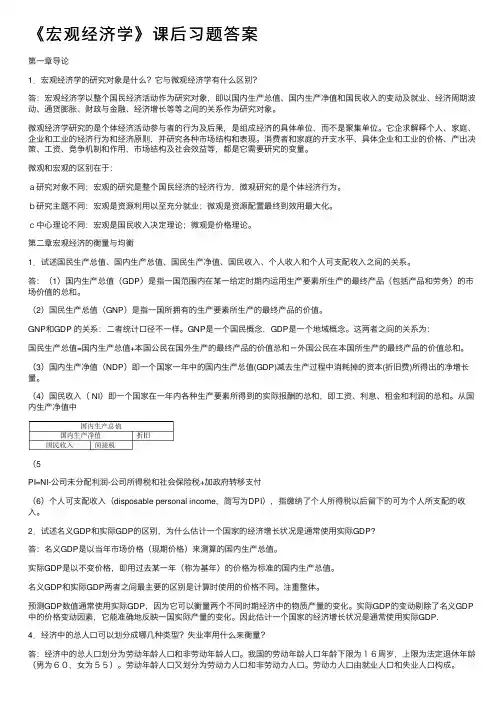
《宏观经济学》课后习题答案第⼀章导论1.宏观经济学的研究对象是什么?它与微观经济学有什么区别?答:宏观经济学以整个国民经济活动作为研究对象,即以国内⽣产总值、国内⽣产净值和国民收⼊的变动及就业、经济周期波动、通货膨胀、财政与⾦融、经济增长等等之间的关系作为研究对象。
微观经济学研究的是个体经济活动参与者的⾏为及后果,是组成经济的具体单位,⽽不是聚集单位。
它企求解释个⼈、家庭、企业和⼯业的经济⾏为和经济原则,并研究各种市场结构和表现。
消费者和家庭的开⽀⽔平、具体企业和⼯业的价格、产出决策、⼯资、竞争机制和作⽤,市场结构及社会效益等,都是它需要研究的变量。
微观和宏观的区别在于:a研究对象不同;宏观的研究是整个国民经济的经济⾏为,微观研究的是个体经济⾏为。
b研究主题不同:宏观是资源利⽤以⾄充分就业;微观是资源配置最终到效⽤最⼤化。
c中⼼理论不同:宏观是国民收⼊决定理论;微观是价格理论。
第⼆章宏观经济的衡量与均衡1.试述国民⽣产总值、国内⽣产总值、国民⽣产净值、国民收⼊、个⼈收⼊和个⼈可⽀配收⼊之间的关系。
答:(1)国内⽣产总值(GDP)是指⼀国范围内在某⼀给定时期内运⽤⽣产要素所⽣产的最终产品(包括产品和劳务)的市场价值的总和。
(2)国民⽣产总值(GNP)是指⼀国所拥有的⽣产要素所⽣产的最终产品的价值。
GNP和GDP 的关系:⼆者统计⼝径不⼀样。
GNP是⼀个国民概念,GDP是⼀个地域概念。
这两者之间的关系为:国民⽣产总值=国内⽣产总值+本国公民在国外⽣产的最终产品的价值总和-外国公民在本国所⽣产的最终产品的价值总和。
(3)国内⽣产净值(NDP)即⼀个国家⼀年中的国内⽣产总值(GDP)减去⽣产过程中消耗掉的资本(折旧费)所得出的净增长量。
(4)国民收⼊( NI)即⼀个国家在⼀年内各种⽣产要素所得到的实际报酬的总和,即⼯资、利息、租⾦和利润的总和。
从国内⽣产净值中(5PI=NI-公司未分配利润-公司所得税和社会保险税+加政府转移⽀付(6)个⼈可⽀配收⼊(disposable personal income,简写为DPI),指缴纳了个⼈所得税以后留下的可为个⼈所⽀配的收⼊。
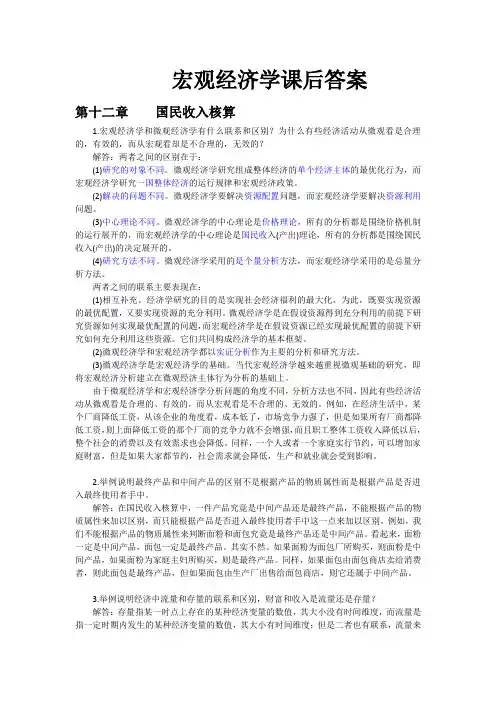
宏观经济学课后答案第十二章国民收入核算1.宏观经济学和微观经济学有什么联系和区别?为什么有些经济活动从微观看是合理的,有效的,而从宏观看却是不合理的,无效的?解答:两者之间的区别在于:(1)研究的对象不同。
微观经济学研究组成整体经济的单个经济主体的最优化行为,而宏观经济学研究一国整体经济的运行规律和宏观经济政策。
(2)解决的问题不同。
微观经济学要解决资源配置问题,而宏观经济学要解决资源利用问题。
(3)中心理论不同。
微观经济学的中心理论是价格理论,所有的分析都是围绕价格机制的运行展开的,而宏观经济学的中心理论是国民收入(产出)理论,所有的分析都是围绕国民收入(产出)的决定展开的。
(4)研究方法不同。
微观经济学采用的是个量分析方法,而宏观经济学采用的是总量分析方法。
两者之间的联系主要表现在:(1)相互补充。
经济学研究的目的是实现社会经济福利的最大化。
为此,既要实现资源的最优配置,又要实现资源的充分利用。
微观经济学是在假设资源得到充分利用的前提下研究资源如何实现最优配置的问题,而宏观经济学是在假设资源已经实现最优配置的前提下研究如何充分利用这些资源。
它们共同构成经济学的基本框架。
(2)微观经济学和宏观经济学都以实证分析作为主要的分析和研究方法。
(3)微观经济学是宏观经济学的基础。
当代宏观经济学越来越重视微观基础的研究,即将宏观经济分析建立在微观经济主体行为分析的基础上。
由于微观经济学和宏观经济学分析问题的角度不同,分析方法也不同,因此有些经济活动从微观看是合理的、有效的,而从宏观看是不合理的、无效的。
例如,在经济生活中,某个厂商降低工资,从该企业的角度看,成本低了,市场竞争力强了,但是如果所有厂商都降低工资,则上面降低工资的那个厂商的竞争力就不会增强,而且职工整体工资收入降低以后,整个社会的消费以及有效需求也会降低。
同样,一个人或者一个家庭实行节约,可以增加家庭财富,但是如果大家都节约,社会需求就会降低,生产和就业就会受到影响。
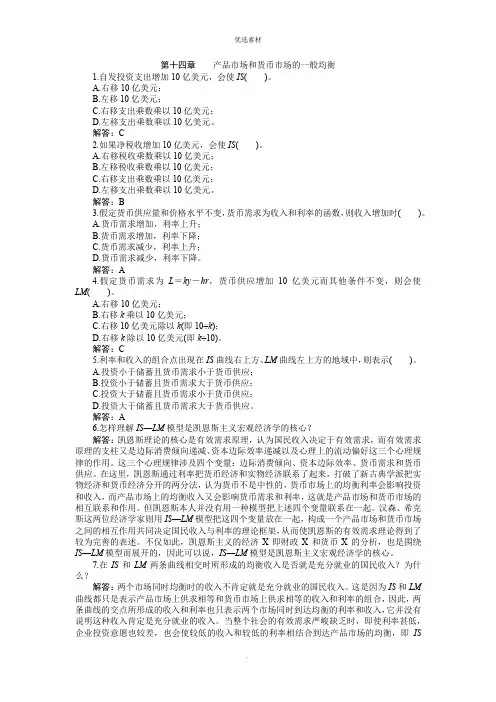
第十四章产品市场和货币市场的一般均衡1.自发投资支出增加10亿美元,会使IS()。
A.右移10亿美元;B.左移10亿美元;C.右移支出乘数乘以10亿美元;D.左移支出乘数乘以10亿美元。
解答:C2.如果净税收增加10亿美元,会使IS()。
A.右移税收乘数乘以10亿美元;B.左移税收乘数乘以10亿美元;C.右移支出乘数乘以10亿美元;D.左移支出乘数乘以10亿美元。
解答:B3.假定货币供应量和价格水平不变,货币需求为收入和利率的函数,则收入增加时()。
A.货币需求增加,利率上升;B.货币需求增加,利率下降;C.货币需求减少,利率上升;D.货币需求减少,利率下降。
解答:A4.假定货币需求为L=ky-hr,货币供应增加10亿美元而其他条件不变,则会使LM()。
A.右移10亿美元;B.右移k乘以10亿美元;C.右移10亿美元除以k(即10÷k);D.右移k除以10亿美元(即k÷10)。
解答:C5.利率和收入的组合点出现在IS曲线右上方、LM曲线左上方的地域中,则表示()。
A.投资小于储蓄且货币需求小于货币供应;B.投资小于储蓄且货币需求大于货币供应;C.投资大于储蓄且货币需求小于货币供应;D.投资大于储蓄且货币需求大于货币供应。
解答:A6.怎样理解IS—LM模型是凯恩斯主义宏观经济学的核心?解答:凯恩斯理论的核心是有效需求原理,认为国民收入决定于有效需求,而有效需求原理的支柱又是边际消费倾向递减、资本边际效率递减以及心理上的流动偏好这三个心理规律的作用。
这三个心理规律涉及四个变量:边际消费倾向、资本边际效率、货币需求和货币供应。
在这里,凯恩斯通过利率把货币经济和实物经济联系了起来,打破了新古典学派把实物经济和货币经济分开的两分法,认为货币不是中性的,货币市场上的均衡利率会影响投资和收入,而产品市场上的均衡收入又会影响货币需求和利率,这就是产品市场和货币市场的相互联系和作用。
但凯恩斯本人并没有用一种模型把上述四个变量联系在一起。
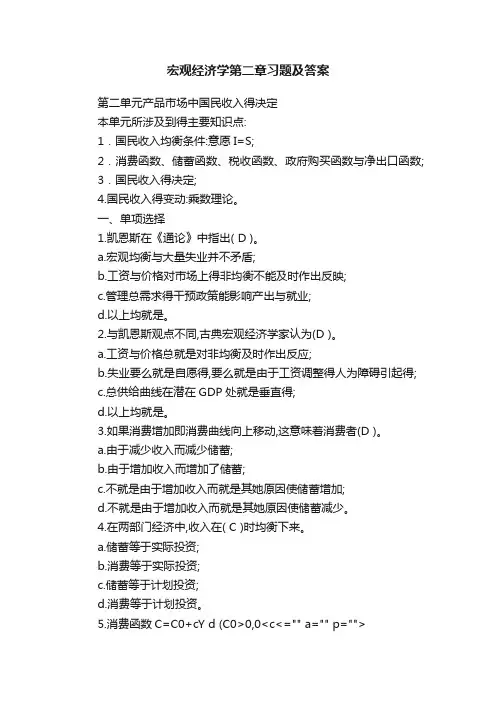
宏观经济学第二章习题及答案第二单元产品市场中国民收入得决定本单元所涉及到得主要知识点:1.国民收入均衡条件:意愿I=S;2.消费函数、储蓄函数、税收函数、政府购买函数与净出口函数; 3.国民收入得决定;4.国民收入得变动:乘数理论。
一、单项选择1.凯恩斯在《通论》中指出( D )。
a.宏观均衡与大量失业并不矛盾;b.工资与价格对市场上得非均衡不能及时作出反映;c.管理总需求得干预政策能影响产出与就业;d.以上均就是。
2.与凯恩斯观点不同,古典宏观经济学家认为(D )。
a.工资与价格总就是对非均衡及时作出反应;b.失业要么就是自愿得,要么就是由于工资调整得人为障碍引起得;c.总供给曲线在潜在GDP处就是垂直得;d.以上均就是。
3.如果消费增加即消费曲线向上移动,这意味着消费者(D )。
a.由于减少收入而减少储蓄;b.由于增加收入而增加了储蓄;c.不就是由于增加收入而就是其她原因使储蓄增加;d.不就是由于增加收入而就是其她原因使储蓄减少。
4.在两部门经济中,收入在( C )时均衡下来。
a.储蓄等于实际投资;b.消费等于实际投资;c.储蓄等于计划投资;d.消费等于计划投资。
5.消费函数C=C0+cY d (C0>0,0<c<="" a="" p="">a.大于边际消费倾向;b.小于边际消费倾向;c.等于边际消费倾向;d.以上三种情况都可能。
6.储蓄函数S=S0+sY d(S0<0,0<s<1)表明,平均储蓄倾向随着可支配收入得增加< p="">( B )。
a.递减;b.递增;c.不变;d.先递减然后递增。
7.凯恩斯之前得古典理论认为( D )。
a.储蓄就是收入得函数,而投资就是利率得函数;b.储蓄与投资都就是收入得函数;c.投资取决于收入,而储蓄取决于利率;d.储蓄与投资都就是利率得函数。
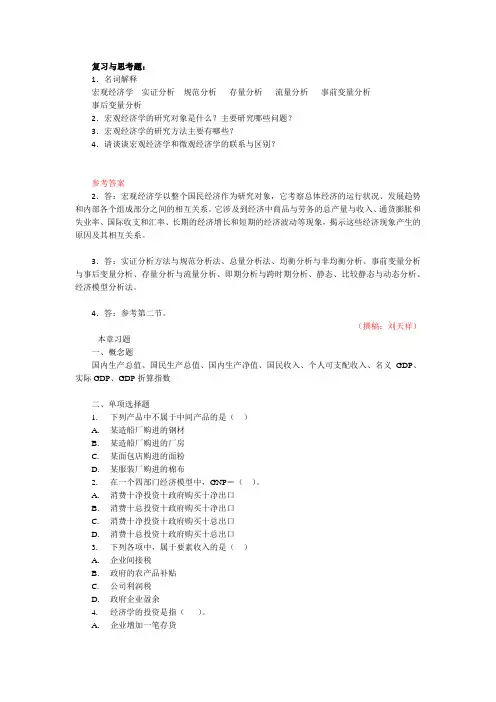
复习与思考题:1.名词解释宏观经济学实证分析规范分析存量分析流量分析事前变量分析事后变量分析2.宏观经济学的研究对象是什么?主要研究哪些问题?3.宏观经济学的研究方法主要有哪些?4.请谈谈宏观经济学和微观经济学的联系与区别?参考答案2.答:宏观经济学以整个国民经济作为研究对象,它考察总体经济的运行状况、发展趋势和内部各个组成部分之间的相互关系。
它涉及到经济中商品与劳务的总产量与收入、通货膨胀和失业率、国际收支和汇率、长期的经济增长和短期的经济波动等现象,揭示这些经济现象产生的原因及其相互关系。
3.答:实证分析方法与规范分析法、总量分析法、均衡分析与非均衡分析、事前变量分析与事后变量分析、存量分析与流量分析、即期分析与跨时期分析、静态、比较静态与动态分析、经济模型分析法。
4.答:参考第二节。
(撰稿:刘天祥)本章习题一、概念题国内生产总值、国民生产总值、国内生产净值、国民收入、个人可支配收入、名义GDP、实际GDP、GDP折算指数二、单项选择题1. 下列产品中不属于中间产品的是()A. 某造船厂购进的钢材B. 某造船厂购进的厂房C. 某面包店购进的面粉D. 某服装厂购进的棉布2. 在一个四部门经济模型中,GNP=()。
A. 消费十净投资十政府购买十净出口B. 消费十总投资十政府购买十净出口C. 消费十净投资十政府购买十总出口D. 消费十总投资十政府购买十总出口3. 下列各项中,属于要素收入的是()A. 企业间接税B. 政府的农产品补贴C. 公司利润税D. 政府企业盈余4. 经济学的投资是指()。
A. 企业增加一笔存货B. 建造一座厂房C. 购买一台机器D. 以上都是5. 已知在第一年名义GNP为500,如到第六年GNP核价指数增加一倍,实际产出上升40%,则第六年的名义GNP为()。
A. 2000B. 1400C. 1000D. 750三、判断题1.农民生产并用于自己消费的粮食不应计入GNP。
()2.在进行国民收入核算时,政府为公务人员加薪,应视为政府购买。
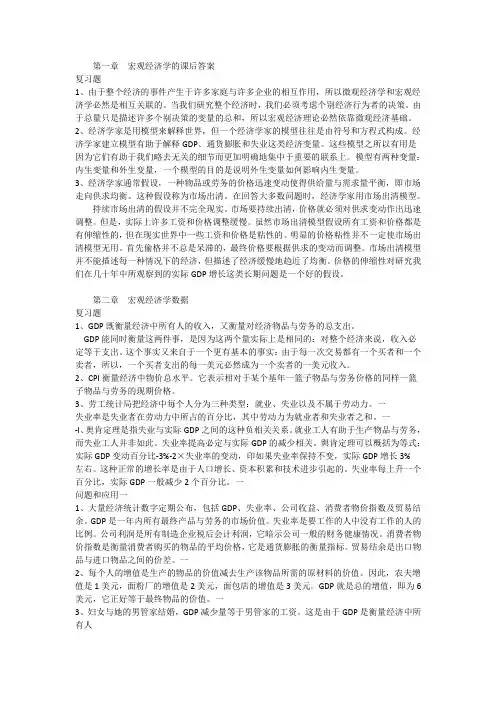
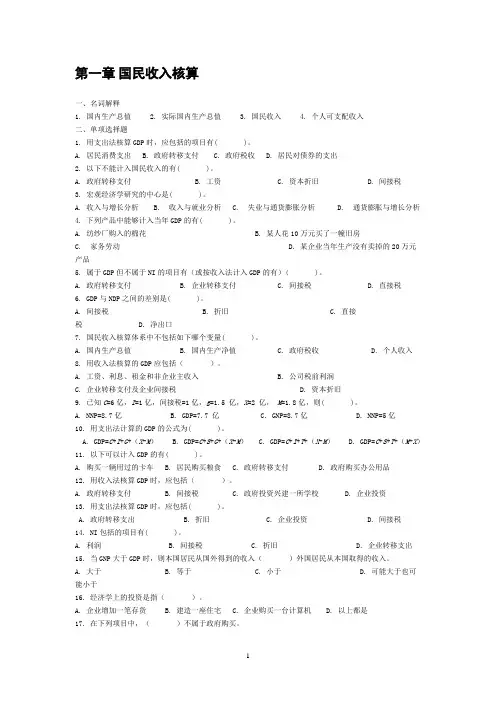
第一章国民收入核算一、名词解释1. 国内生产总值2. 实际国内生产总值3. 国民收入4. 个人可支配收入二、单项选择题1. 用支出法核算GDP时,应包括的项目有( )。
A. 居民消费支出B. 政府转移支付C. 政府税收D. 居民对债券的支出2. 以下不能计入国民收入的有( )。
A. 政府转移支付B. 工资C. 资本折旧D. 间接税3. 宏观经济学研究的中心是( )。
A. 收入与增长分析B. 收入与就业分析C. 失业与通货膨胀分析D. 通货膨胀与增长分析4. 下列产品中能够计入当年GDP的有( )。
A. 纺纱厂购入的棉花B. 某人花10万元买了一幢旧房C. 家务劳动D. 某企业当年生产没有卖掉的20万元产品5. 属于GDP但不属于NI的项目有(或按收入法计入GDP的有)( )。
A. 政府转移支付B. 企业转移支付C. 间接税D. 直接税6. GDP与NDP之间的差别是( )。
A. 间接税B. 折旧C. 直接税 D. 净出口7. 国民收入核算体系中不包括如下哪个变量( )。
A. 国内生产总值B. 国内生产净值C. 政府税收D. 个人收入8. 用收入法核算的GDP应包括()。
A. 工资、利息、租金和非企业主收入B. 公司税前利润C. 企业转移支付及企业间接税D. 资本折旧9. 已知C=6亿,I=1亿,间接税=1亿,g=1.5 亿,X=2 亿,M=1.8亿,则( )。
A. NNP=8.7亿B. GDP=7.7 亿C. GNP=8.7亿D. NNP=5亿10. 用支出法计算的GDP的公式为( )。
A. GDP=C+I+G+(X-M)B. GDP=C+S+G+(X-M)C. GDP=C+I+T+(X-M)D. GDP=C+S+T+(M-X)11. 以下可以计入GDP的有( )。
A. 购买一辆用过的卡车B. 居民购买粮食C. 政府转移支付D. 政府购买办公用品12. 用收入法核算GDP时,应包括()。
A. 政府转移支付B. 间接税C. 政府投资兴建一所学校D. 企业投资13. 用支出法核算GDP时,应包括( )。
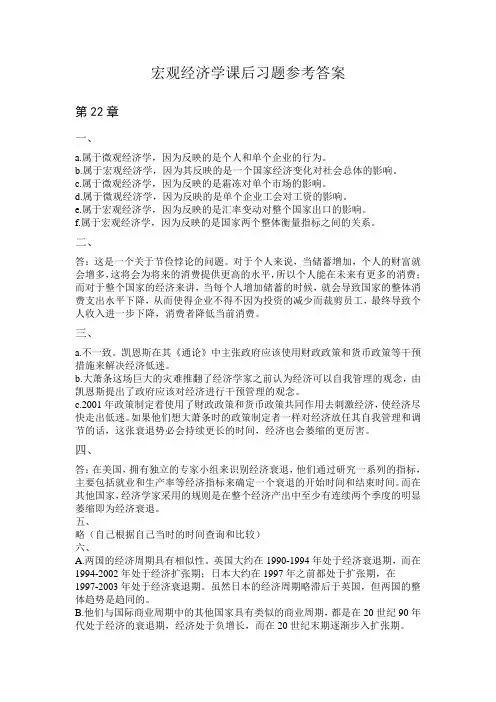
宏观经济学课后习题参考答案第22章一、a.属于微观经济学,因为反映的是个人和单个企业的行为。
b.属于宏观经济学,因为其反映的是一个国家经济变化对社会总体的影响。
c.属于微观经济学,因为反映的是霜冻对单个市场的影响。
d.属于微观经济学,因为反映的是单个企业工会对工资的影响。
e.属于宏观经济学,因为反映的是汇率变动对整个国家出口的影响。
f.属于宏观经济学,因为反映的是国家两个整体衡量指标之间的关系。
二、答:这是一个关于节俭悖论的问题。
对于个人来说,当储蓄增加,个人的财富就会增多,这将会为将来的消费提供更高的水平,所以个人能在未来有更多的消费;而对于整个国家的经济来讲,当每个人增加储蓄的时候,就会导致国家的整体消费支出水平下降,从而使得企业不得不因为投资的减少而裁剪员工,最终导致个人收入进一步下降,消费者降低当前消费。
三、a.不一致。
凯恩斯在其《通论》中主张政府应该使用财政政策和货币政策等干预措施来解决经济低迷。
b.大萧条这场巨大的灾难推翻了经济学家之前认为经济可以自我管理的观念,由凯恩斯提出了政府应该对经济进行干预管理的观念。
c.2001年政策制定着使用了财政政策和货币政策共同作用去刺激经济,使经济尽快走出低迷。
如果他们想大萧条时的政策制定者一样对经济放任其自我管理和调节的话,这张衰退势必会持续更长的时间,经济也会萎缩的更厉害。
四、答:在美国,拥有独立的专家小组来识别经济衰退,他们通过研究一系列的指标,主要包括就业和生产率等经济指标来确定一个衰退的开始时间和结束时间。
而在其他国家,经济学家采用的规则是在整个经济产出中至少有连续两个季度的明显萎缩即为经济衰退。
五、略(自己根据自己当时的时间查询和比较)六、A.两国的经济周期具有相似性。
英国大约在1990-1994年处于经济衰退期,而在1994-2002年处于经济扩张期;日本大约在1997年之前都处于扩张期,在1997-2003年处于经济衰退期。
虽然日本的经济周期略滞后于英国,但两国的整体趋势是趋同的。
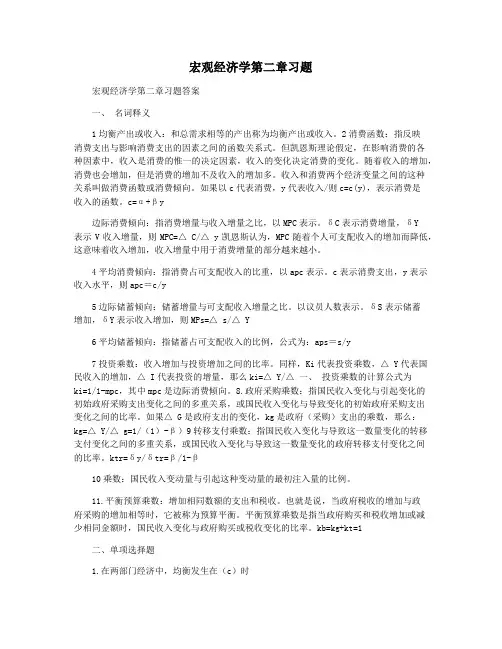
宏观经济学第二章习题宏观经济学第二章习题答案一、名词释义1均衡产出或收入:和总需求相等的产出称为均衡产出或收入。
2消费函数:指反映消费支出与影响消费支出的因素之间的函数关系式。
但凯恩斯理论假定,在影响消费的各种因素中,收入是消费的惟一的决定因素,收入的变化决定消费的变化。
随着收入的增加,消费也会增加,但是消费的增加不及收入的增加多。
收入和消费两个经济变量之间的这种关系叫做消费函数或消费倾向。
如果以c代表消费,y代表收入/则c=c(y),表示消费是收入的函数。
c=α+βy边际消费倾向:指消费增量与收入增量之比,以MPC表示。
δC表示消费增量,δY表示V收入增量,则MPC=△ C/△ y凯恩斯认为,MPC随着个人可支配收入的增加而降低,这意味着收入增加,收入增量中用于消费增量的部分越来越小。
4平均消费倾向:指消费占可支配收入的比重,以apc表示。
c表示消费支出,y表示收入水平,则apc=c/y5边际储蓄倾向:储蓄增量与可支配收入增量之比。
以议员人数表示。
δS表示储蓄增加,δY表示收入增加,则MPs=△ s/△ Y6平均储蓄倾向:指储蓄占可支配收入的比例,公式为:aps=s/y7投资乘数:收入增加与投资增加之间的比率。
同样,Ki代表投资乘数,△ Y代表国民收入的增加,△ I代表投资的增量,那么ki=△ Y/△ 一、投资乘数的计算公式为ki=1/1-mpc,其中mpc是边际消费倾向。
8.政府采购乘数:指国民收入变化与引起变化的初始政府采购支出变化之间的多重关系,或国民收入变化与导致变化的初始政府采购支出变化之间的比率。
如果△ G是政府支出的变化,kg是政府(采购)支出的乘数,那么:kg=△ Y/△ g=1/(1)-β)9转移支付乘数:指国民收入变化与导致这一数量变化的转移支付变化之间的多重关系,或国民收入变化与导致这一数量变化的政府转移支付变化之间的比率。
ktr=δy/δtr=β/1-β10乘数:国民收入变动量与引起这种变动量的最初注入量的比例。
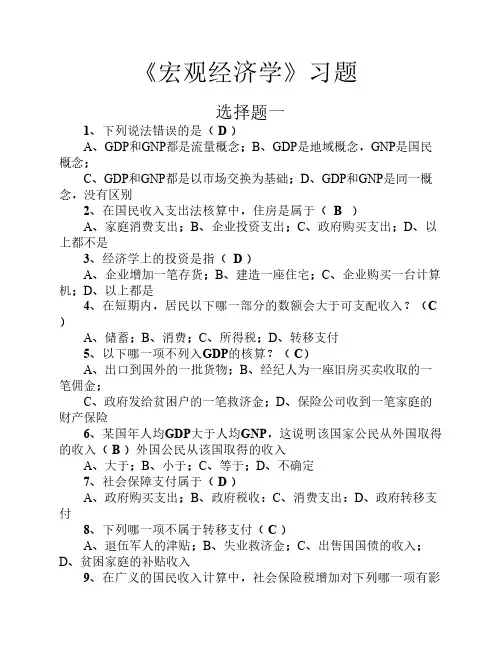
《宏观经济学》习题选择题一1、下列说法错误的是( D )A、GDP和GNP都是流量概念;B、GDP是地域概念,GNP是国民概念;C、GDP和GNP都是以市场交换为基础;D、GDP和GNP是同一概念,没有区别2、在国民收入支出法核算中,住房是属于( B )A、家庭消费支出;B、企业投资支出;C、政府购买支出;D、以上都不是3、经济学上的投资是指( D )A、企业增加一笔存货;B、建造一座住宅;C、企业购买一台计算机;D、以上都是4、在短期内,居民以下哪一部分的数额会大于可支配收入?(C )A、储蓄;B、消费;C、所得税;D、转移支付5、以下哪一项不列入GDP的核算?( C)A、出口到国外的一批货物;B、经纪人为一座旧房买卖收取的一笔佣金;C、政府发给贫困户的一笔救济金;D、保险公司收到一笔家庭的财产保险6、某国年人均GDP大于人均GNP,这说明该国家公民从外国取得的收入( B )外国公民从该国取得的收入A、大于;B、小于;C、等于;D、不确定7、社会保障支付属于( D )A、政府购买支出;B、政府税收:C、消费支出:D、政府转移支付8、下列哪一项不属于转移支付( C )A、退伍军人的津贴;B、失业救济金;C、出售国国债的收入;D、贫困家庭的补贴收入9、在广义的国民收入计算中,社会保险税增加对下列哪一项有影响(D )A、GNP;B、NNP;C、NI;D、PI10、下列不属于政府购买支出的是(A )A、政府为低收入者提供的生活保障;B、政府为政府公务员增加工资;C、政府向国外购买一批先进武器;D、政府在农村新建100所学校11、在国民收入核算中,下列哪一项不属于要素收入但被计入个人可支配收入中( B )A、租金;B、养老金;C、银行存款利息;D、拥有股票所获得的红利收入12、在下面四种情况中,投资乘数最大的是( C )A、MPC为0.6;B、MPC为0.3;C、MPS为0.1;D、MPS为0.313、如果投资增加120亿元,MPC为0.6,则收入水平将增加(A )A、300亿元;B、200亿元;C、720亿元;D、400亿元14、MPC与MPS之和等到于1,这是因为( C )A、任何两个边际量相加总是等于1;B、MPC和MPS都是直线;C、在简单的凯恩斯宏观经济模型中,国民收入不是用于消费,就是用于储蓄;D、经济中的投资水平不变15、投资乘数等于( B)A、投资变化除以收入变化;B、收入变化除以投资变化;C、边际消费倾向的倒数;D、(1-MPS)的倒数16、根据凯恩斯消费理论,随着收入增加( C )A、消费增加、储蓄下降;B、消费下降、储蓄增加;C、消费增加、储蓄增加;D、消费下降、储蓄下降17、在经济学中,下面哪一种行为被视为投资( C )A、购买公司证券;B、购买国债;C、建办公楼;D、生产性活动导致的当前消费18、如果资本边际效率低于市场利率,则企业投资( A )A、过多;B、过少;C、正好:D、都不对19、决定投资的因素不包括( D )A、利息率;B、资本边际效率;C、投资的利润率;D、国民收入20、IS曲线表示满足( D )关系A、收入-支出均衡;B、总供给和总需求均衡;C、储蓄和投资均衡;D、以上都对21、IS曲线上存在储蓄和投资均衡的收入和利率的组合点有( B )A、一个;B、无数个;C、一个或无数个;D、零个22、货币市场和商品市场的同时均衡,可以理解为( B )A、各种收入水平和各种利率水平上;B、一种收入水平和一定利率水平上;C、各种收入水平和一定利率水平上;D、一种收入水平和各种利率水平上23、如果人们的收入增加,则增加的将是( A )A、货币的交易需求;B、A和C;C、货币的投机需求;D、都不变动24、对利率变动反应最为敏感的是( C )A、货币的交易需求;B、货币的预防需求;C、货币的投机需求;D、ABC相同25、在经济萧条时期,政府可以采取的政策有( D )A、扩张性财政和紧缩性货币政策;B、紧缩性财政和紧缩性货币政策;C、紧缩性财政和扩张性货币政策;D、扩张性的财政和货币政策26、在古典区域内(A )A、货币政策有效;B、财政政策有效;C、货币政策无效;D、两者都有效27、在凯恩斯区域内(B )A、货币政策有效;B、财政政策有效;C、财政政策无效;D、两者都有效28、经济中存在失业时,应采取的财政政策工具是( A )A、增加政府支出;B、提高个人所得税;C、提高公司所得税;D、增加货币发行量29、在经济过热时,政府应采取( B )的财政政策A、扩大政府财政支出;B、减少财政支出;C、扩大财政赤字;D、减少税收30、实际GDP与潜在GDP的关系是(D )A、总是相等;B、实际GDP总是低于潜在GDP;C、实际GDP总是高于潜在GDP;D、实际GDP可以大于也可以小于或者等于潜在GDP,一般情况下,实际GDP小于潜在GDP31、在其他条件不变的情况下,如果价格水平下降,则总需求( A)A、增加;B、不变;C、减少;D、难以确定32、加速原理断言(A )A、GDP的增加导致投资数倍增加;B、GDP的增加导致投资数位减少;C、投资的增加导致GDP数位增加;D、投资的增加导致GDP数倍减少33、下述哪一项说法正确地表述了加速原理( D )A、投资的变动引起国民收入的数倍变动;B、消费支出随着投资的变动而数倍变动;C、投资的变动引起国民收入增长率数倍变动;D、消费需求的变动引起投资的倍数变动34、导致经济波动的投资主要是( D )A、存货投资;B、重置投资;C、愿意投资;D、固定资产投资35、在充分就业的情况下,下列( D )因素最可能导致通货膨胀A、进口增加;B、工资不变但劳动生产率提高;C、出口减少;D、政府支出不变但税收减少36、在下列引起通货膨胀的原因中,(C )最可能是成本推进的通货膨胀的原因A、银行存款增加;B、预算赤字;C、世界性商品价格的上涨;D、投资增加37、按照(D)的观点,菲利普斯曲线所阐明的通货膨胀率和失业率之间的替代关系是不存在的A、凯恩斯主义;B、货币主义;C、供给学派;D、理性预期学派38、“适应性预期”与“理性预期“的区别主要在( A)A、前者强调过去信息,后者强调现有的信息;B、后者以大量数学模型为论证依据,因而更科学;C、前者是凯恩斯主义的理论假设,内容陈旧,应被淘汰;D、前者难以解释与过去完全不一样的未来经济变动39、货币主义坚持以( B )作为货币政策的惟一控制指标A、利率;B、货币供给量;C、信货流量;D、准备金40、下面哪一种排序是经济周期阶段的正确顺序?( A )A、扩张—顶点—收缩—谷底;B、扩张-顶点-谷底-收缩;C、扩张-谷底—顶点-收缩;D、收缩-谷底—顶点—扩张41、某人正在等待某项工作,这种情况可以归类于( A)A、失业;B、就业;C、非劳动力;D、就业不足42、一个社会实现了充分就业,这就意味着( D )A、人人都有工作;B、想工作的人都有工作;C、失业率等于0;D、失业率处于自然失业率水一43、减少失业的政策,很可能会带来什么影响( B )A、没有影响;B、物价上涨;C、经济增长速度降低;D、以上都不对44、煤炭有多种用途,作为最终产品的是( A )A、家庭用于做饭;B、餐馆用于做饭;C、供热公司用于供应暖气;D、化工厂用作原材料45、下面不属于流量的是(C )A、国内生产总值;B、总投资;C、一国的资本量;D、净出口46、下面属于政府购买支出的是(A )A、空军购买一战机;B、退伍军人津贴;C、失业救济金;D、退休金47、如果消费函数为C=100+0.8(Y-T),则政府支出乘数是(D )A、8;B、1.25;C、4;D、548、可支配收入中,边际储蓄倾向如果为0.25,则边际消费倾向为( B )A、0.25;B、0.75;C、1.0;D、0.6449、国民收入决定理论认为国民收入均衡水平决定于(C )A、总收入;B、总投资;C、总需求;D、总供给50、平均储蓄倾向随收入的增加而(B )A、递减;B、递增;C、不变;D、不能确定51、如果MPC为0.8,则增加100亿元的投资将导致国民收入增加( C)亿元A、100;B、200;C、500;D、80052、在下列情况下,投资乘数最大的是(A )A、MPC=0.9;B、MPC=0.8;C、MPC=0.75;D、MPC=0.2553、边际消费倾向与边际储蓄倾向之和等于( D )A、大于1的正数;B、小于2的正数;C、0;D、154、根据消费函数,引起消费增加的因素是(B )A、价格水平下降;B、收入增加;C、储蓄增加;D、利率提高55、根据加速原理,引起净投资的原因是( A )A、产出的增加;B、价格提高;C、利息率下降;D、工资下降56、两部门经济的均衡国民收入决定的条件是( C )A、C=S;B、C=T;C、I=S;D、M=I57、三部门经济的均衡国民收入决定的条件是( A )A、Y=C+I+G;B、Y=C+I+T;C、C=Y+I+G;D、G=Y-C+I58、下列不会使均衡国民收入增加的情况是( D )A、税收减少;B、投资增加;C、政府购买增加;D、税收增加59、经济增长的标志是( D )A、失业率的下降;B、先进技术的使用;C、CPI的降低;D、社会生产能力的不断提高60、经济周期的中心是( C )A、价格的波动;B、利率的波动;C、国民收入的波动;D、就业率的波动61、导致LM曲线向右移动的因素有( D )A、投机货币需求减少;B、交易货币需求减少;C、货币供给量减少;D、货币供给量增加62、LM曲线表示满足以下哪一种关系?( D)A、收入-支出均衡;B、总供给与总需求均衡;C、储蓄与投资均衡;D、货币供求均衡63、如果某人因为某行业不景气而失去了工作,这种失业应属于( A )A、结构性失业;B、摩擦性失业;C、周期性失业;D、季节性失业64、天气寒冷,游客大大减少,某旅游区部分人失业,这种失业应属于( D )A、结构性失业;B、摩擦性失业;C、周期性失业;D、季节性失业65、下列哪一类不属于失业人员?( D )A、季节性工人;B、对当前工作不满意而待业在家的人;C、正在寻找工作的大学毕业生;D、半日工66、如果某人大学毕业后刚进入劳动力队伍还尚未找到工作,应属于(B )A、结构性失业;B、摩擦性失业;C、周期性失业;D、季节性失业67、为了降低失业率,应采取的货币政策工具是( B )A、提高税收;B、增加货币供给量;C、提高失业救济金;D、增加政府支出68、如果出现通货膨胀,实行的财政政策应是( B )A、减少税收;B、减少政府购买;C、增加转移支付;D、减少货币供给量69、根据菲利普斯曲线,降低通货膨胀率的办法是(A )A、提高失业率;B、降低失业率;C、实现充群分就业;D、增加货币供给量70、由于存在信息不对称或不完全信息所引起的失业属于( D )A、非自愿意失业;B、结构性失业;C、需求不足失业;D、摩擦性失业71、自然失业率指的是( C )A、是没有摩擦性失业时的失业率;B、是没有结构性失业时的失业率;C、是经济处于潜在产出水平时的失业率;D、恒为072、长期菲利普斯曲线表明( B )A、政府宏观经济政策只在一定范围内有效;B、政府宏观经济政策无效;C、自然失业率可以变动;D、失业与通货膨胀不可并存73、在其他条件不变情况下,政府增加公共设施投资,会引起国民收入( A )A、增加;B、不变;C、减少:D、不确定74、“双紧”政策会使国民收入( B )A、增加:B、减少:C、不变;D、不确定75、当一国经济出现过热时,中央银行可以在金融市场上( B)A、卖出国债,降低再贴现率;B、卖出国债,提高再贴现率;C、买进国债,降低再贴现率;D、买进国债,提高再贴现率76、( D)不能使LM曲线产生位移A、公开市场业务;B、降低法定准备金率;C、通货膨胀;D、扩大政府购买77、假定自然失业率是5%,而实际失业率是9%,根据奥肯定律GDP缺口占潜在GDP的比例为 (B )A、4%;B、8%;C、10%;D、不确定78、已知2012和2013年的CPI分别为140.3和144.5,则2014年的通货膨胀率大约为( B )A、6.7%;B、3.0%;C、10%;D、13.6%选择题二1、宏观经济学的中心理论是( C )A、价格决定理论B、工资决定理论C、国民收入决定理论D、汇率决定理论2、实际GDP等于( B )A、价格水平除以名义GDPB、名义GDP除以价格水平C、名义GDP乘以价格水平D、价格水平乘以潜在GDP3、已知消费为100亿元,投资为40亿元,间接税为50亿,政府的物品和劳务支出额为60亿,净出口为10亿元,则( D)A、NDP=210亿元B、GNP=210亿元C、NDP=120亿元D、无法确定GNP4、假定A国2010年和2013年的名义GDP分别为12000亿元和20000亿元,GDP的折算数分别为1、0和1、5,可推论2013年比2010年(C)A、名义GDP上升33%B、实际GDP不变C、实际GDP上升11%D、实际GDP下降5、如果某人个人收入等于8700元,个人所得税等于900元,消费5300元,利息支付总额为500元,个人储蓄2000元,则个人可支配收入等于(B)A、7300元B、7800元C、5800元D、无法确定6、甲公司为乙公司提供市场营销策划服务,双方约定报酬为10万元,事后乙公司为甲公司提供了价值6万元的产品直接抵消了部分策划费用,再用2万元的售后服务抵消了剩余策划费用的部分款项,最后支付2万元现金给甲公司。
第9章总供给一、选择题二、名词解释1、不完全信息模型:不完全信息模型是阐述经济主体在做出经济决策时,并不能掌握所有相关信息从而影响总供给的模型。
不完全信息模型假设市场出清,即所有工资和价格自由调整使供求平衡,短期和长期总供给曲线的不同是因为对价格暂时的错觉。
此外,该模型还假设,经济中的每个供给者生产一种单一产品并消费许多产品。
由于产品数量如此之多,供给者无法在所有时间中观察到所有价格。
他们密切注视他们所生产的产品的价格,但对他们消费的所有产品的价格关注较不密切。
由于信息不完全,他们有时混淆了物价总水平的变动与相对价格的变动。
这种混淆影响了供给多少的决策,并导致物价水平与产出之间在短期的正相关关系。
当物价水平发生了未预期到的上升时,经济中所有供给者都观察到了自己所生产的产品价格的上升。
他们都理性而错误地推断,他们生产的产品的相对价格上升了。
他们更努力地工作,并生产得更多。
总之,不完全信息模型说明,当实际物价超过预期物价时,供给者增加其产出。
由Y=Y+α(P-P e)可知,当产出背离预期物价水平时,产出背离自然率。
2、黏性价格模型:性价格模型即阐述黏性价格对总供给影响的模型。
黏性价格指不能迅速反映产品市场供求的变动,只能缓慢地根据产品市场状况改变而调整的价格。
该模型假设市场是完全竞争的,完全竞争企业是价格接受者,而不是价格制定者。
该模型表示为Y=Y+α(P-P e ),说明了产出与自然率的背离和物价水平与预期物价水平的背离是正相关的。
3、菲利普斯曲线:菲利普斯曲线是表示货币工资变动率与失业率之间交替关系的曲线。
它是英国经济学家菲利普斯根据1861~1957年英国的失业率和货币工资变动率的经验统计资料提出来的,故称之为菲利普斯曲线。
这条曲线表示,当失业率高时,货币工资增长率低;反之,当失业率低时,货币工资增长率高。
因此,如图9-2-1所示,横轴代表失业率(U),纵轴代表货币工资增长率(W),菲利普斯曲线(PC)是一条向右下方倾斜的曲线。
宏观经济学-课后思考题答案_史蒂芬威廉森002Chapter 2MeasurementTeaching GoalsStudents must understand the importance of measuring aggregate economic activity. Macroeconomics hopes to produce theories that provide useful insights and policy conclusions. To be credible, such theories must produce hypotheses that evidence could possibly refute. Macroeconomic measurement provides such evidence. Without macroeconomic measurements, macroeconomics could not be a social science, and would rather consist of philosophizing and pontificating. Market transactions provide the most simple and direct measurements. Macroeconomists’ most basic measurement is Gross Domestic Product (GDP), the value of final, domestically market output produced during a given period of time.In the United States, the Commerce Department’s National Income and Product Accounts provide official estimates of GDP. These accounts employ their own set of accounting rules to ensure internal consistency and to provide several separate estimates of GDP. These separate estimates are provided by the product accounts, the expenditure accounts, and the income accounts. The various accounting conventions may, at first glance, be rather dry and complicated. However, students can only easily digest the material in later chapters if they have a good grounding in the fundamentals.GDP changes through time because different amounts of goods and services are produced, and such goods and services are sold at different prices. Standards of living are determined by the amounts of goods and services produced, not by the prices they command in the market. While GDP is relatively easy to measure, the decomposition of changes in real GDP into quantity and price components is much more difficult. This kind of problem is less pressing for microeconomists. It is easy to separately measure the number of apples sold and the price of each apple. Because macroeconomics deals with aggregate output, the differentiation of price and quantity is much less easily apparent. It is important to emphasize that while there may be more or less reasonable approaches to this problem, there is no unambiguous best approach. Since many important policy discussions involve debates about output and price measurements, it is very important to understand exactly how such measurements are produced.Classroom Discussion TopicsAs the author demonstrates in presenting this chapter’s material, much of this material is best learned by example. Rather than simply working through the examples from the text or making up your own, the material may resonate better if the students come up with their own examples. They can start by picking a single good, and by the choice of their numbers they provide their own implied decomposition of output into wage and profit income. Later on, encourage them to suggest intermediate input production, inventory adjustments, international transactions, a government sector, and so on. Such an exercise may help assure them that the identities presented in the text are more than simply abstract constructions.If many of your students are familiar with accounting principles, it may also be useful to present the National Income and Product Account with the “T” accounts. Highlighting how every income is an expense elsewhere. Make one account for each of the firms, one for the household and one for the government. Add another account for the rest of the world when discussing the example with international trade. This procedure can highlight how some entities can be inferred from others because accounting10 Williamson ? Macroeconomics, Third Editionidentities must hold. It makes it also easier to determine consumption for some student Social Security benefits are indexed to the Consumer Price Index. Explain with an example exactly how these adjustments are made. Ask the students if they think that this procedure is “fair.” Another topic for concern is the stagnation in the growth of measured real wages. Real wages are measured by dividing (for example) average hourly wages paid in manufacturing by the consumer price index. Ask students if measured changes in real wages confirm or conflict with their general beliefs about whether the typical worker is better or worse off than 10 or 20 years ago. How does possible mis-measurement of prices reconcile any apparent differences between casual impressions and statistical evidence?The text discusses why unemployment may or may not be a good measure of labor market tightness. Another interpretation of the unemployment rate is as a(n inverse) measure of economic welfare. Ask the students if they agree with this interpretation. Does the unemployment rate help factor in considerations like equal distribution of income? How can the unemployment rate factor in considerations like higher income per employed worker? Discuss possible pros and cons of using unemployment rather than per capita real GDP as a measure of well-being. Can unemployment be too low? Why or why not?OutlineI. Measuring GDP: The National Income and Product AccountsA. What Is GDP and How Do We Measure It?1. GDP: Value of Domestically Produced Output2. Commerce Department’s National Income and Product Accounts3. Business, Consumer, and Government AccountingB. The Product Approach1. Value Added2. Intermediate Good InputsC. The Expenditure Approach1. Consumption2. Investment3. Government Spending4. Net ExportsD. The Income Approach1. Wage Income2. After-Tax Profits3. Interest Income4. Taxes5. The Income-Expenditure IdentityE. Gross National Product (GNP)1. Treatment of Foreign Income2. GNP = GDP + Net Foreign IncomeF. What Does GDP Leave Out?1. GDP and Welfarea. Income Distributionb. Non-Market Production2. Measuring Market Productiona. The Underground Economyb. Valuing Government ProductionChapter 2 Measurement 11G. Expenditure Components1. Consumptiona. Durable Goodsb. Non-Durable Goodsc. Services2. Investmenta. Fixed Investment: Nonresidential and Residentialb. Inventory Investment3. Net Exportsa. Exportsb. Imports4. Government Expendituresa. Federal Defenseb. Federal Non-Defensec. State and Locald. Treatment of Transfer PaymentsII. Nominal and Real GDP and Price IndicesA. Real GDP1. Output Valued at Base Year Prices2 Chain Weighted Real GDPB. Measures of the Price Level1. Implicit GDP Price Deflator2. Consumer Price Index (CPI)C. Problems Measuring Real GDP and Prices1. Substitution Biases2. Accounting for Quality Changes3. Treatment of Newly Introduced GoodsIII. Savings, Wealth, and CapitalA. Stocks and FlowsB. Private Disposable Income and Private Sector Saving1.d Y Y NFP TR INT T =+++? 2.p d S Y C =? C. Government Surpluses, Deficits, and Government Saving1.g S T TR INT G = 2. g D S =? D. National Saving: p g S S S Y NFP C G =+=+??E. Saving, Investment, and the Current Account1. NFP NX I S ++=2. CA I S NFP NX CA +=?+=F. The Stock of Capital1. Wealth ΔS ?2. K I Δ?3. Claims on Foreigners CA ?12 Williamson ? Macroeconomics, Third EditionIV. Labor Market MeasurementA. BLS Categories1. Employed2. Unemployed3. Not in the Labor ForceB. The Unemployment RateNumber unemployed=Unemployment RateLabor forceC. The Participation RateLabor force=Participation RateTotal working age populationD. Unemployment and Labor Force Tightness1. Discouraged Workers2. Job Search IntensityTextbook Question SolutionsQuestions for Review1. Product, income, and expenditure approaches.2. For each producer, value added is equal to the value of total production minus the cost ofintermediate inputs.3. This identity emphasizes the point that all sales of output provide income somewhere in the economy.The identity also provides two separate ways of measuring total output in the economy.4. GNP is equal to GDP (domestic production) plus net factor payments from abroad. Net factorpayments represent income for domestic residents that are earned from production that takes place in foreign countries. 5. GDP provides a reasonable approximation of economic welfare. However, GDP ignores the value ofnonmarket economic activity. GDP also measures only total income without reference to how that income is distributed. 6. Measured GDP does not include production in the underground economy, which is difficult toestimate. GDP also measures the value of government spending at its cost of production, which may be greater or less than its true value.7. The largest component is consumption, which represents about 2/3 of GDP.8. Investment is equal to private, domestic expenditure on goods and services (Y ? G ? NX) minusconsumption. Investment includes residential investment, nonresidential investment, and inventory investment.9. National defense spending represents about 5% of GDP.Chapter 2 Measurement 13 10. GDP values production at market prices. Real GDP compares different years’ production at a specificset of prices. These prices are those that prevailed in the base year. Real GDP is therefore a weighted average of individual production levels. The weights are determined according to prevailing relative prices in the base year. Because relative prices change over time, comparisons of real GDP across time can differ according to the chosen base year.11. Chain weighting directly compares production levels only in adjacent years. The price weights aredetermined by averaging the prices of the individual goods and services over the two adjacent years.12. Real GDP is difficult to measure due to changes over time in relative prices, difficulties in estimatingthe extent of quality changes, and how one estimates the value of newly introduced goods.13. Private saving measures additions to private sector wealth. Government saving measures reductionsin government debt (increases in government wealth). National saving measures additions to national wealth. National saving is equal to private saving plus government saving.14. National wealth is accumulated as increases in the domestic stock of capital (domestic investment)and increases in claims against foreigners (the current account surplus).15. Measured unemployment excludes discouraged workers. Measured unemployment only accounts forthe number of individuals unemployed, without reference to how intensively they search for newjobs.Problems1. Product accounting adds up value added by all producers. The wheat producer has no intermediateinputs and produces 30 million bushels at $3/bu. for $90 million. The bread producer produces100 million loaves at $3.50/loaf for $350 million. The bread producer uses $75 million worth ofwheat as an input. Therefore, the bread producer’s value added is $275 million. Total GDP istherefore $90 million + $275 million = $365 million.Expenditure accounting adds up the value of expenditures on final output. Consumers buy100 million loaves at $3.50/loaf for $350 million. The wheat producer adds 5 million bushels ofwheat to inventory. Therefore, investment spending is equal to 5 million bushels of wheat valued at $3/bu., which costs $15 million. Total GDP is therefore $350 million + $15 million = $365 million.2. Coal producer, steel producer, and consumers.(a) (i) Product approach: Coal producer produces 15 million tons of coal at $5/ton, which adds$75 million to GDP. The steel producer produces 10 million tons of steel at $20/ton, whichis worth $200 million. The steel producer pays $125 million for 25 million tons of coal at$5/ton. The steel producer’s value added is therefore $75 million. GDP is equal to$75 million + $75 million = $150 million.(ii) Expenditure approach: Consumers buy 8 million tons of steel at $20/ton, so consumption is $160 million. There is no investment and no government spending. Exports are 2 milliontons of steel at $20/ton, which is worth $40 million. Imports are 10 million tons of coal at$5/ton, which is worth $50 million. Net exports are therefore equal to $40 million ?$50 million =?$10 million. GDP is therefore equal to $160 million + (?$10 million) =$150 million.14 Williamson ? Macroeconomics, Third Edition(iii) Income approach: The coal producer pays $50 million in wages and the steel producer pays $40 million in wages, so total wages in the economy equal $90 million. The coal producerreceives $75 million in revenue for selling 15 million tons at $15/ton. The coal producerpays $50 million in wages, so the coal producer’s profits are $25 million. The steel producerreceives $200 million in revenue for selling 10 million tons of steel at $20/ton. The steelproducer pays $40 million in wages and pays $125 million for the 25 million tons ofcoal that it needs to produce steel. The steel producer’s profits are therefore equal to$200 million ? $40 million ? $125 million = $35 million. Total profit income in theeconomy is therefore $25 million + $35 million = $60 million. GDP therefore is equal towage income ($90 million) plus profit income ($60 million). GDP is therefore $150 million.(b) There are no net factor payments from abroad in this example. Therefore, the current accountsurplus is equal to net exports, which is equal to (?$10 million).(c) As originally formulated, GNP is equal to GDP, which is equal to $150 million. Alternatively, ifforeigners receive $25 million in coal industry profits as income, then net factor payments from abroad are (?$25 million), so GNP is equal to $125 million.3. Wheat and Bread(a) Product approach: Firm A produces 50,000 bushels of wheat, with no intermediate goods inputs. At$3/bu., the value of Firm A’s production is equal to $150,000. Firm B produces 50,000 loaves ofbread at $2/loaf, which is valued at $100,000. Firm B pays $60,000 to firm A for 20,000 bushels of wheat, which is an intermediate input. Firm B’s value added is therefore $40,000. GDP is therefore equal to $190,000.(b) Expenditure approach: Consumers buy 50,000 loaves of domestically produced bread at $2/loafand 15,000 loaves of imported bread at $1/loaf. Consumption spending is therefore equal to$100,000 + $15,000 = $115,000. Firm A adds 5,000 bushels of wheat to inventory. Wheat isworth $3/bu., so investment is equal to $15,000. Firm A exports 25,000 bushels of wheat for$3/bu. Exports are $75,000. Consumers import 15,000 loaves of bread at $1/loaf. Imports are$15,000. Net exports are equal to $75,000 ? $15,000 = $60,000. There is no governmentspending. GDP is equal to consumption ($115,000) plus investment ($15,000) plus net exports($60,000). GDP is therefore equal to $190,000.(c) Income approach: Firm A pays $50,000 in wages. Firm B pays $20,000 in wages. Total wagesare therefore $70,000. Firm A produces $150,000 worth of wheat and pays $50,000 in wages.Firm A’s profits are $100,000. Firm B produces $100,000 worth of bread. Firm B pays $20,000in wages and pays $60,000 to Firm A for wheat. Firm B’s profits are $100,000 ? $20,000 ?$60,000 = $20,000. Total profit income in the economy equals $100,000 + $20, 000 = $120,000.Total wage income ($70,000) plus profit income ($120,000) equals $190,000. GDP is therefore$190,000.Chapter 2 Measurement 15 4. Price and quantity data are given as the following.Year 1Good Quanti tyPri ceComputers 20$1,000 Bread 10,000$1.00Year 2Good Quanti tyPri ceComputers 25$1,500Bread 12,000$1.10(a) Year 1 nominal GDP =×+×=20$1,00010,000$1.00$30,000.Year 2 nominal GDP =×+×=25$1,50012,000$1.10$50,700.With year 1 as the base year, we need to value both years’ production at year 1 prices. In the base year, year 1, real GDP equals nominal GDP equals $30,000. In year 2, we need to value year 2’s output at year 1 prices. Year 2 real GDP =×+×= 25$1,00012,000$1.00$37,000. The percentage change in real GDP equals ($37,000 ? $30,000)/$30,000 = 23.33%.We next calculate chain-weighted real GDP. At year 1 prices, the ratio of year 2 real GDP to year1 real GDP equals g1= ($37,000/$30,000) = 1.2333. We must next compute real GDP using year2 prices. Year 2 GDP valued at year 2 prices equals year 2 nominal GDP = $50,700. Year 1 GDPvalued at year 2 prices equals (20 × $1,500 + 10,000 × $1.10) = $41,000. The ratio of year 2 GDP at year 2 prices to year 1 GDP at year 2 prices equals g2=chain-weighted ratio of real GDP in the two years therefore is equal to 1.23496cg==. The percentage change chain-weighted real GDP from year 1 to year 2 is therefore approximately23.5%.If we (arbitrarily) designate year 1 as the base year, then year 1 chain-weighted GDP equals nominal GDP equals $30,000. Year 2 chain-weighted real GDP is equal to (1.23496 × $30,000) = $37,048.75.(b) To calculate the implicit GDP deflator, we divide nominal GDP by real GDP, and then multiplyby 100 to express as an index number. With year 1 as the base year, base year nominal GDP equals base year real GDP, so the base year implicit GDP deflator is 100. For the year 2, the implicit GDP deflator is ($50,700/$37,000) × 100 = 137.0. The percentage change in the deflator is equal to 37.0%.With chain weighting, and the base year set at year 1, the year 1 GDP deflator equals($30,000/$30,000) × 100 = 100. The chain-weighted deflator for year 2 is now equal to($50,700/$37,048.75) × 100 = 136.85. The percentage change in the chain-weighted deflator equals 36.85%.16 Williamson ? Macroeconomics, Third Edition(c) We next consider the possibility that year 2 computers are twice as productive as year1 computers. As one possibility, let us define a “computer” as a year 1 computer. In this case,the 25 computers produced in year 2 are the equivalent of 50 year 1 computers. Each year 1computer now sells for $750 in year 2. We now revise the original data as:Year 1Good Quanti tyPri ceYear 1 Computers 20 $1,000Bread 10,000$1.00Year 2Good Quanti tyPri ceYear 1 Computers 50 $750Bread 12,000$1.10First, note that the change in the definition of a “computer” does not affect the calculations of nominal GDP. We next compute real GDP with year 1 as the base year. Year 2 real GDP in year 1 prices is now ×+×=50$1,00012,000$1.00$62,000. The percentage change in real GDP is equal to ($62,000 ? $30,000)/$30,000 = 106.7%. We next revise the calculation of chain-weighted real GDP. From above, g1 equals($62,000/$30,000) = 206.67. The value of year 1 GDP at year 2 prices equals $26,000. Therefore,g 2 equals ($50,700/$26,000) = 1.95. 200.75. The percentage change chain-weighted real GDPfrom year 1 to year 2 is therefore 100.75%.If we (arbitrarily) designate year 1 as the base year, then year 1 chain-weighted GDP equalsnominal GDP equals $30,000. Year 2 chain-weighted real GDP is equal to (2.0075 × $30,000) = $60,225. The chain-weighted deflator for year 1 is automatically 100. The chain-weighteddeflator for year 2 equals ($50,700/$60,225) × 100 = 84.18. The percentage rate of change of the chain-weighted deflator equals ?15.8%.When there is no quality change, the difference between using year 1 as the base year and using chain weighting is relatively small. Factoring in the increased performance of year 2 computers, the production of computers rises dramatically while its relative price falls. Compared withearlier practices, chain weighting provides a smaller estimate of the increase in production and a smaller estimate of the reduction in prices. This difference is due to the fact that the relative price of the good that increases most in quantity (computers) is much higher in year 1. Therefore, the use of historical prices puts more weight on the increase in quality-adjusted computer output. 5. Price and quantity data are given as the following:Year 1GoodQuantity(million lbs.)Price(per lb.)Broccoli 1,500 $0.50 Cauliflower 300$0.80Year 2GoodQuantity(million lbs.)Price(per lb.)Broccoli 2,400 $0.60 Cauliflower 350$0.85Chapter 2 Measurement 17(a) Year 1 nominal GDP = Year 1 real GDP =×+×=1,500million$0.50300million$0.80 $990million.Year 2 nominal GDP=×+×=2,400million$0.60350million$0.85$1,730.5million Year 2 real GDP=×+×=2,400million$0.50350million$0.80$1,450million.Year 1 GDP deflator equals 100.Year 2 GDP deflator equals ($1,730.5/$1,450) × 100 = 119.3.The percentage change in the deflator equals 19.3%.(b) Year 1 production (market basket) at year 1 prices equals year 1 nominal GDP = $990 million.The value of the market basket at year 2 prices is equal to ×+×1,500million$0.60300million $0.85= $1,050 million.Year 1 CPI equals 100.Year 2 CPI equals ($1,050/$990) × 100 = 106.1.The percentage change in the CPI equals 6.1%.The relative price of broccoli has gone up. The relative quantity of broccoli has also gone up. The CPI attaches a smaller weight to the price of broccoli, and so the CPI shows less inflation.6. Corn producer, consumers, and government.(a) (i) Product approach: There are no intermediate goods inputs. The corn producer grows30 million bushels of corn. Each bushel of corn is worth $5. Therefore, GDP equals$150 million.(ii) Expenditure approach: Consumers buy 20 million bushels of corn, so consumption equals $100 million. The corn producer adds 5 million bushels to inventory, so investment equals$25 million. The government buys 5 million bushels of corn, so government spendingequals $25 million. GDP equals $150 million.(iii) Income approach: Wage income is $60 million, paid by the corn producer. The corn producer’s revenue equals $150 million, including the value of its addition to inventory. Additions toinventory are treated as purchasing one owns output. The corn producer’s costs includewages of $60 million and taxes of $20 million. Therefore, profit income equals $150 million ?$60 million ? $20 million = $70 million. Government income equals taxes paid by the cornproducer, which equals $20 million. Therefore, GDP by income equals $60 million +$70 million + $20 million = $150 million.(b) Private disposable income equals GDP ($150 million) plus net factor payments (0) plusgovernment transfers ($5 million is Social Security benefits) plus interest on the government debt ($10 million) minus total taxes ($30 million), which equals $135 million. Private saving equalsprivate disposable income ($135 million) minus consumption ($100 million), which equals$35 million. Government saving equals government tax income ($30 million) minus transferpayments ($5 million) minus interest on the government debt ($10 million) minus governmentspending ($5 million), which equals $10 million. National saving equals private saving($35 million) plus government saving ($10 million), which equals $45 million. The government budget surplus equals government savings ($10 million). Since the budget surplus is positive, the government budget is in surplus. The government deficit is therefore equal to (?$10 million).18 Williamson ? Macroeconomics, Third Edition7. Price controls.Nominal GDP is calculated by measuring output at market prices. In the event of effective pricecontrols, measured prices equal the controlled prices. However, controlled prices reflect an inaccurate measure of scarcity values. Nominal GDP is therefore distorted. In addition to distortions in nominal GDP measures, price controls also inject an inaccuracy in attempts to decompose changes in nominal GDP into movements in real GDP and movements in prices. With price controls, there is typically little or no change in white market prices over time. Alternatively, black market or scarcity value prices typically increase, perhaps dramatically. Measures of prices (in terms of scarcity values) understate inflation. Whenever inflation measures are too low, changes in real GDP overstate the extent of increases in actual production.8. Underground economy.Transactions in underground economy are performed with cash exclusively, to exploit the anonymous nature of currency. Thus, once we have established the amount of currency held abroad, we know the portion of $2,474 that is held domestically. Remove from it what is used for recorded transactions, say by using some estimate of the proportion of transactions using cash and applying this to observed GDP. Finally apply a concept of velocity of money to the remaining amount of cash to obtain the size of the underground economy.9. S p– 1 = CA + D(a) By definition:p d S Y C Y NFP TR INT T C =?=+++?? Next, recall that .Y C I G NX =+++ Substitute into the equation above and subtract I to obtain:()()p S I C I G NX NFP INT T C INX NFP G INT TR T CA D ?=+++++=++++?=+(b) Private saving, which is not used to finance domestic investment, is either lent to the domesticgovernment to finance its deficit (D ), or is lent to foreigners (CA ).10. Computing capital with the perpetual inventory method.(a) First, use the formula recursively for each year:K 0 = 80K 1 = 0.9 × 80 + 10 = 82K 2 = 0.9 × 82 + 10 = 83.8K 3 = 0.9 × 83.8 + 10 = 85.42K 4 = 0.9 × 85.42 + 10 = 86.88K 5 = 0.9 × 86.88 + 10 = 88.19K 6 = 0.9 × 88.19 + 10 = 89.37K 7 = 0.9 × 89.37 + 10 = 90.43K 8 = 0.9 × 90.43 + 10 = 91.39K 9 = 0.9 × 91.39 + 10 = 92.25K 10 = 0.9 × 92.25 + 10 = 93.03(b) This time, capital stays constant at 100, as the yearly investment corresponds exactly to theamount of capital that is depreciated every year. In (a), we started with a lower level of capital, thus less depreciated thanwhat was invested, as capital kept rising (until it would reach 100). Chapter 2 Measurement 19 11. Assume the following: 10540308010520D INT T G C NFP CA S =======?= (a) 201080110d p Y S C S D C =+=++=++= (b)103054015D G TR INT T TR D G INT T =++?=??+=??+= (c) 208030130S GNP C G GNP S C G =??=++=++= (d)13010120GDP GNP NFP =?=?= (e)Government Surplus 10g S D ==?=? (f)51015CA NX NFP NX CA NFP =+=?=??=? (g) 12080301525GDP C I G NXI GDP C G NX =+++==??+=。
《宏观经济学》章节习题及答案解析第一章导论1、怎样理解宏观经济学的研究对象?【解答】宏观经济学研究的对象是经济的总体行为。
它的基本研究方法是考察经济的总体趋势,采用总量分析法。
它解决的主要中心问题经济周期与失业、通货膨胀和经济增长。
与微观经济学不同,宏观经济学则主要研究整体经济,以产出、失业、通货膨胀这些大范围内的经济现象为研究对象,其目的是对产出、失业以及价格的变动作出经济解释,宏观经济学的研究方法则是总量分析,即对能够反映整个经济运行情况的经济变量的决定、变动及其相互关系进行分析。
这些总量包括两类,一类是个量的总和,另一类是平均量。
因此,宏观经济学又称为“总量经济学”。
《宏观经济学》章节习题及答案解析第二章国民收入核算1、下列项目是否计入GDP,为什么?(1)政府转移支付(2)购买一辆用过的卡车(3)购买普通股票(4)购买一块地产【解答】(1)政府转移支付不计入GDP,因为政府转移支付只是简单地通过税收(包括社会保障税)和社会保险及社会救济等把收入从一个人或一个组织转移到另一个人或另一个组织手中,并没有相应的货物或劳务发生。
例如,政府给残疾人发放救济金,并不是残疾人创造了收入;相反,倒是因为他丧失了创造收入的能力从而失去生活来源才给予救济的。
(2)购买一辆用过的卡车不计入GDP,因为在生产时已经计入过。
(3)购买普通股票不计入GDP,因为经济学上所讲的投资是增加或替换资本资产的支出,即购买新厂房,设备和存货的行为,而人们购买股票和债券只是一种证券交易活动,并不是实际的生产经营活动。
(4)购买一块地产也不计入GDP,因为购买地产只是一种所有权的转移活动,不属于经济意义的投资活动,故不计入GDP。
2、如果甲乙两国并成一个国家,对GDP 总和会有什么影响(假定两国产出不变)?【解答】如果甲乙两国合并成一个国家,对GDP 总和会有影响。
因为甲乙两国未合并成一个国家时,双方可能有贸易往来,但这种贸易只会影响甲国或乙国的GDP,对两国GDP 总和不会有影响。
第四章货币与通货膨胀一、选择题二、名词解释1、M1与M2:都是美联储计算货币存量的指标,M1是指通货加活期存款、旅行支票和其它支票性存款,被称为狭义的货币;M2是指加货币市场基金余额、储蓄存款以及小额定期存款,被称为广义的货币。
M1具有完全的流动性,但没有利息。
M2有利息但不具有完全的流动性。
M1与经济关联性强,而M2与货币政策关联性强。
2、货币需求函数:(1)货币需求函数是为了分析货币需求量的决定因素及其变动规律而建立的一种函数关系。
通常将决定和影响货币需求的各种因素作为自变量,而将货币需求本身作为因变量。
(2)比较典型的货币需求函数有:①传统货币数量论的交易方程式:PV=MY,其中M为货币数量,V为货币流通速度,P为一般物价水平,Y为实际国民收入;②剑桥方程式:M= kPY,其中M为货币数量,k为以货币形式持有的国民收入的比例,P为一般物价水平,Y为实际国民收入;③凯恩斯的货币需求函数:L=L1(Y)+L2(i)。
其中由交易动机和预防动机而产生的货币需求用L1表示,是收入Y的递增函数,即L1=L1(Y);投机性货币需求L2则与利率有关,是利率的递减函数,即L2=L2(i);④弗里德曼的货币需求函数:M=f{P,r b,r c,1/P·dP/dt,w,y,u},其中,M表示名义货币量,P表示价格水平,r b表示债券的预期收益率,r c表示股票的预期收益率,1/P·dP/dt表示物价的预期变动率,w表示人力财富与非人力财富的比率,y表示货币收入,u为其他随机因素。
3、数量方程式:数量方程式是用来表示交易量与货币之间的关系的方程。
它有以下表示形式:MV=PT式中,M为流通中的货币数量,V为货币的流通速度,P为一般物价水平,T为社会总交易额。
交易方程式直观地表示了流通中的货币数量与一般物价水平之间的关系。
如果用Y代表实际GDP,P是GDP平减指数,而PY是名义GDP,数量方程式变为MV=PY。
第19章 经济增长一、概念(略) 二、单选题答案三、简答题答案1. 说明经济增长与经济发展的关系。
经济增长是产量的增加,这里的产量可以表示为经济的总产量,也可表示成人均产量。
经济增长通常用经济增长率度量。
经济发展不仅包括经济增长,还包括国民的生活质量,以及整个社会经济结构和制度结构的总体进步。
经济发展是反映一个经济社会总体发展水平的综合性概念。
如果说经济增长是一个“量”的概念,那么经济发展就是一个“质”的概念。
2、经济增长的含义和源泉在宏观经济学中,经济增长通常被定义为产量的增加。
具体理解有两层含义:(1)经济增长指一个经济体所产生的物质产品和劳务在一个相当长时期内的持续增长,即经济总产量的增长;(2)经济增长是按人口平均计算的实际产出的持续增长,即人均产量的增长。
作为经济增长源泉的最主要的因素是:劳动数量增加和质量提高(即人力资本的增长)、资本存量的增加和技术进步(是广义概念,包括采用新技术、新产品、先进管理手段以及资源配置的高效率等)。
增长率的分解式为:K L A Y G G G G βα++=,式中,G Y 为产出的增长率;G A 为技术进步增长率;G L 和G K 分别为劳动和资本的增长率;a 和β为参数,分别是劳动和资本的产出弹性。
3、在新古典经济增长模型中,稳态增长的条件是什么?在新古典经济增长模型中,稳态增长的条件为人均资本不发生变化,或者说每人使用的资本量不变,这就要使人均储蓄正好等于资本的广化。
在新古典经济增长模型公式sf (k )=Δk+nk 中,人均资本不发生变化即Δk =0,则sf (k )=nk 。
sf (k )是储蓄率与人均产量(或人均收入)的乘积,即人均储蓄,nk 是资本的广化。
在宏观经济学中,储蓄等于投资是均衡的条件,储蓄等于储蓄率乘以收入,即S=sY 。
投资可用资本增量ΔK 表示。
而上述公式sf (k )=nk 即sy=nk ,y=Y/N 表示人均收入,k 表示每一劳动力或每一人口配备的资本量,即k=K/N 。
黄亚均《宏观经济学》(第二版)计算题解答第三章复习思考题9.有A、B两个国家。
两国的生产函数相同:y=k1/2(y,k分别为每单位有效劳动产出和每单位有效劳动资本)。
A国的储蓄率s A=28%,人口增长率n A=1%,B国的储蓄率s B=10%,人口增长率n B=4%。
两国有相同的技术进步率g=2%,折旧率δ=4%。
求:稳态时,(1)A国和B国的每单位有效劳动资本k和每单位有效劳动产出y分别是多少?(2)A国和B国的人均产出增长率和人均资本增长率分别是多少?(3)A国和B国的总产出增长率(ΔY/Y)和资本增长率(ΔK/K)分别是多少?(4)两国的资本积累是否达到了黄金律水平?为什么?(5)对两国的情况进行比较分析,B国为提高人均收入(产出)水平应该采取什么政策?解答:(1)根据稳态条件:s·y=(δ+ n+ g)k,把得y=k1/2带入:s·k0.5=(δ+ n+ g)k,k0.5=s/(δ+ n+ g)。
稳态时,A国:每单位有效劳动资本k A=16,每单位有效劳动产出y A=4;B国:每单位有效劳动资本k B=1,每单位有效劳动产出y B=1。
(2)A国的人均产出增长率和人均资本增长率为:Δ(Y/N)=Δ(K/N)=g=2%;B国的人均产出增长率和人均资本增长率为:Δ(Y/N)=Δ(K/N)=g=2%。
(3)A国的总产出增长率和资本增长率为:(ΔY/Y)=(ΔK/K)=n+g=3%;B国的总产出增长率和资本增长率为:(ΔY/Y)=(ΔK/K)=n+g=6%。
(4)黄金律水平的条件为:MP k=(δ+ n+ g),A国黄金律水平的条件应为:MP k=7%,而A国稳态时的MP k=dy/dk=0.5k-0.5=0.5×16-0.5=1/8=12.5%;B国黄金律水平的条件应为:MP k=10%,而B国稳态时的MP k=dy/dk=0.5k-0.5=0.5×1-0.5=1/2=50%。